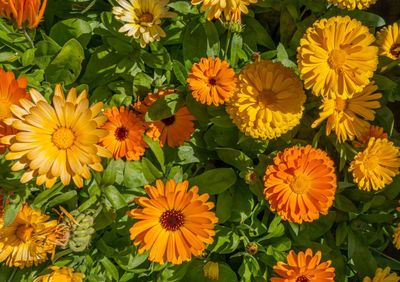Introduction
- Overview: Calendula, also known as pot marigold, is a cheerful, easy-to-grow flower grown for its herbal uses, and pollinator-friendly nature.
- Why grow it: Calendula is easy to grow, easy to save seed, and an ideal addition to edible gardens.
Quick Facts
- Type: Annual
- Height: 12-24" tall and wide
- Bloom Season: Fall through spring (may survive through summer in some cooler parts)
- Sun Requirements: Full sun, afternoon shade can extend blooms into warmer months
- Water Needs: Low once established
- Soil Type: Well draining soil
Planting Guide
When to Plant
- In most of California, calendula grows best when planted in the cooler months.
- Plant in early spring or late summer for fall blooms.
- Calendula can tolerate light frosts and prefers mild temperatures. Once established, it can bloom through winter in our mostly frost-free zone.
Where to Plant
- Calendula thrives in full sun but can tolerate partial shade, especially in hotter inland areas. Choose a spot with well-draining soil, it doesn't have to be particularly fertile, but it doesn’t like soggy roots.
- Calendula also performs well in containers, window boxes, and raised beds, as long as there is good drainage.
How to Plant
- Calendula is easy to grow from seed. Direct sowing is best, though it can also be started indoors and transplanted while still young.
- Sow seeds about a quarter-inch deep, spacing them a few inches apart. Keep the soil moist until seedlings emerge, usually within 5–10 days.
- Thin seedlings to about 8–12 inches apart once they’re a few inches tall.
Care & Maintenance
Watering
- Calendula prefers moderate watering. Water regularly while young, then reduce as the plant matures. Overwatering can lead to mildew or root problems.
Fertilizing
- Calendula typically doesn’t need much, if any, feeding. If grown in containers or very poor soil, a light feeding with compost or a diluted organic fertilizer once or twice during the season is plenty.
- Avoid over-fertilizing. It may lead to excessive leafy growth with fewer flowers.
Deadheading
- Deadhead spent flowers regularly to prolong blooming and prevent self-seeding if you don’t want volunteers. That said, letting a few go to seed can ensure free flowers next season!
Pests & Problems
- Calendula is relatively pest-resistant but can occasionally be affected by:
- Aphids: Hose or squish them off. Treat a bad infestation with insecticidal soap.
- Powdery mildew: Provide good air circulation and avoid overhead watering.
- Snails and slugs: Protect young seedlings if needed.
Lifecycle & Reseeding
- At the end of the season, let some flower heads dry on the plant. The seeds are large and easy to collect. Store in a cool, dry place and replant next season. Calendula also often self-sows if left undisturbed.
Wildlife & Companion Benefits
- Calendula is a pollinator magnet and makes an excellent companion in vegetable gardens. It helps attract beneficial insects like ladybugs and parasitic wasps, which prey on pests. It’s also said to repel some harmful insects such as aphids and whiteflies.
- Try planting calendula near tomatoes, lettuce, or brassicas for beauty and benefit.
Extra Tips
- To harvest for herbal use, pick flowers in the morning. Dry them in a warm, dark spot with good airflow.
- The petals are edible and can be used fresh in salads or dried for teas and skin-soothing salves.
Where to Get Seeds
